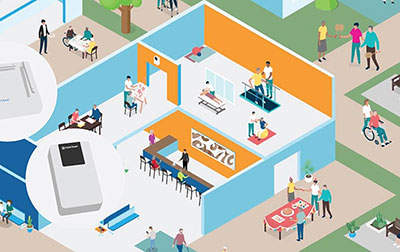The world of business is constantly evolving, and one of the most important evolutions in recent years is the rise of real-time location systems (RTLS). RTLS is a technology that uses radio frequency identification (RFID) technology to track and monitor the location of people and objects in real-time. This can provide valuable insights into a company's operations, allowing them to make informed decisions and optimize their processes.
The benefits of using RTLS are numerous. For one, it can help businesses to improve their customer service by allowing them to quickly and accurately locate products or employees in their facility. This can result in faster response times for customers, and a more efficient use of resources.
Furthermore, RTLS can also help businesses to improve their supply chain management by monitoring the movement of products and materials within their facilities. This can help to identify inefficiencies and areas for improvement, and optimize their processes to reduce costs and increase profitability.
Another major benefit of RTLS is increased safety and security. By tracking the location of employees and assets in real-time, businesses can quickly respond to emergencies and ensure that everyone is safe. This can be especially important in industries where safety is a top priority, such as healthcare, construction, and transportation.
There are many different types of RTLS technologies available, and businesses can choose the one that best fits their needs. For example, some RTLS systems use active RFID tags which require a power source, while others use passive RFID tags which don't require a power source. Active RFID tags provide greater accuracy and range, while passive RFID tags are less expensive and require less maintenance.
Of course, there are also some challenges and limitations to RTLS that businesses need to consider. For example, the initial investment in installing an RTLS system can be significant, and the technology can be complicated to implement. It is important to work with a knowledgeable installer and understand the potential drawbacks before committing to an RTLS system.

In addition, there are also privacy concerns associated with using RTLS technology, as it can potentially track the movements of employees and customers. It is important for businesses to have clear policies in place regarding the use and storage of location data, and to communicate these policies to all stakeholders.
Ultimately, RTLS is a powerful technology that can help businesses to make informed decisions and optimize their operations. By using RTLS, businesses can gain a deeper understanding of their operations and improve their customer service, supply chain management, safety, and security. While there are certainly some challenges and limitations that must be considered, the benefits of using RTLS are wide-ranging and significant.
The process of implementing an RTLS system can be complex and time-consuming, but the results can be well worth the effort. It is important to work with an experienced installer and consult with experts in the field to ensure that the system is well-suited to the specific needs of the business. It is also important to set clear goals and objectives, and to constantly measure the performance of the system in order to make adjustments and improvements as needed.
As technology continues to evolve, it is likely that RTLS will become even more powerful and widely used. By investing in this technology, businesses can stay ahead of the curve and gain a competitive advantage over their peers. The future of RTLS is bright, and businesses that choose to embrace it are poised to succeed in the fast-paced and ever-changing world of commerce.